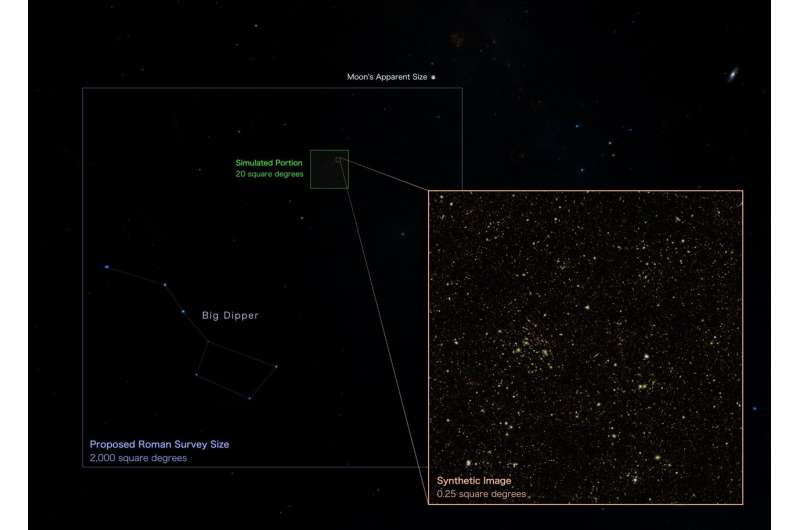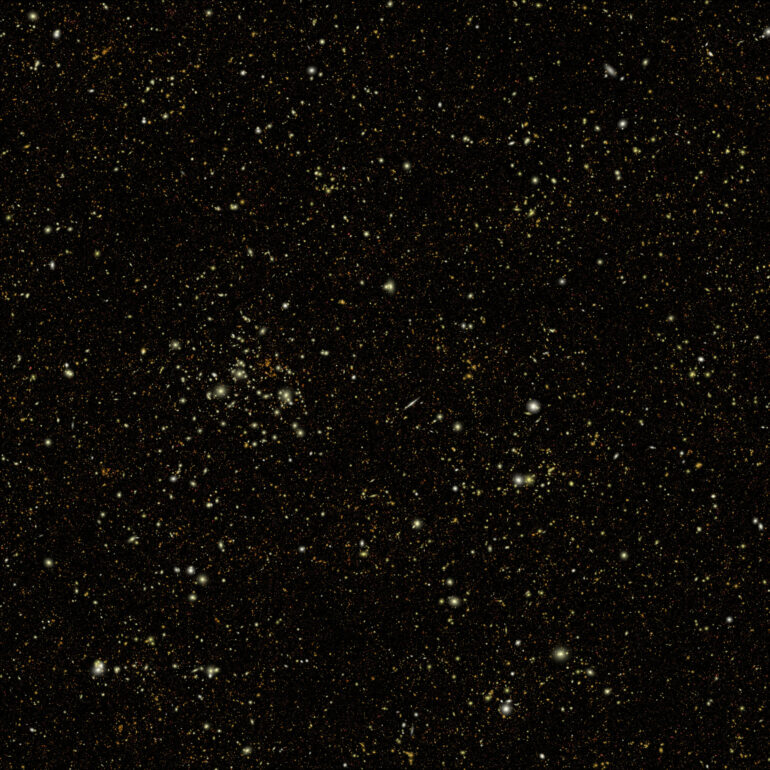Scientists have created a gargantuan synthetic survey that shows what we can expect from the Nancy Grace Roman Space Telescope’s future observations. Though it represents just a small chunk of the real future survey, this simulated version contains a staggering number of galaxies—33 million of them, along with 200,000 foreground stars in our home galaxy.
The simulation will help scientists plan the best observing strategies, test different ways to mine the mission’s vast quantities of data, and explore what we can learn from tandem observations with other telescopes.
“The volume of data Roman will return is unprecedented for a space telescope,” said Michael Troxel, an assistant professor of physics at Duke University in Durham, North Carolina. “Our simulation is a testing ground we can use to make sure we will get the most out of the mission’s observations.”
The team drew data from a mock universe originally developed to support science planning with the Vera C. Rubin Observatory, which is located in Chile and set to begin full operations in 2024. Because the Roman and Rubin simulations use the same source, astronomers can compare them and see what they can expect to learn from pairing the telescopes’ observations once they’re both actively scanning the universe.
A paper describing the results, led by Troxel, has been accepted for publication in The Monthly Notices of the Royal Astronomical Society.
Cosmic construction
Roman’s High Latitude Wide Area Survey will consist of both imaging—the focus of the new simulation—and spectroscopy across the same enormous swath of the universe. Spectroscopy involves measuring the intensity of light from cosmic objects at different wavelengths, while Roman’s imaging will reveal precise positions and shapes of hundreds of millions of faint galaxies that will be used to map dark matter. Although this mysterious substance is invisible, astronomers can infer its presence by observing its effects on regular matter.
Anything with mass warps the fabric of space-time. The bigger the mass, the greater the warp. This creates an effect called gravitational lensing, which happens when light from a distant source becomes distorted as it travels past intervening objects. When those lensing objects are massive galaxies or galaxy clusters, background sources can be smeared or appear as multiple images.
Less massive objects can create more subtle effects called weak lensing. Roman will be sensitive enough to use weak lensing to see how clumps of dark matter warp the appearance of distant galaxies. By observing these lensing effects, scientists will be able to fill in more of the gaps in our understanding of dark matter.

This graphic compares the relative sizes of the synthetic image (inset, outlined in orange), the whole area astronomers simulated (the square in the upper-middle outlined in green), and the size of the complete future survey astronomers will conduct (the large square in the lower-left outlined in blue). The background, from the Digitized Sky Survey, illustrates how much sky area each region covers. The synthetic image covers about as much sky as a full moon, and the future Roman survey will cover much more area than the Big Dipper. While it would take the Hubble Space Telescope or James Webb Space Telescope around a thousand years to image an area as large as the future survey, Roman will do it in just over seven months. © NASA’s Goddard Space Flight Center and M. Troxel
“Theories of cosmic structure formation make predictions for how the seed fluctuations in the early universe grow into the distribution of matter that can be seen through gravitational lensing,” said Chris Hirata, a physics professor at Ohio State University in Columbus, and a co-author of the paper.
“But the predictions are statistical in nature, so we test them by observing vast regions of the cosmos. Roman, with its wide field of view, will be optimized to efficiently survey the sky, complementing observatories such as the James Webb Space Telescope that are designed for deeper investigation of individual objects.”
Ground and space
The synthetic Roman survey covers 20 square degrees of the sky, which is roughly equivalent to 95 full moons. The actual survey will be 100 times larger, unveiling more than a billion galaxies. Rubin will scan an even greater area—18,000 square degrees, nearly half of the entire sky—but with lower resolution since it will have to peer through Earth’s turbulent atmosphere.
Pairing the Roman and Rubin simulations offers the first opportunity for scientists to try to detect the same objects in both sets of images. That’s important because ground-based observations aren’t always sharp enough to distinguish multiple, close sources as separate objects. Sometimes they blur together, which affects weak lensing measurements. Now, scientists can determine the difficulties and benefits of “deblending” such objects in Rubin images by comparing them with Roman ones.
With Roman’s colossal cosmic view, astronomers will be able to accomplish far more than the survey’s primary goals, which are to study the structure and evolution of the universe, map dark matter, and discern between the leading theories that attempt to explain why the expansion of the universe is speeding up. Scientists can comb through the new simulated Roman data to get a taste of the bonus science that will come from seeing so much of the universe in such exquisite detail.
“With Roman’s gigantic field of view, we anticipate many different scientific opportunities, but we will also have to learn to expect the unexpected,” said Julie McEnery, the senior project scientist for the Roman mission at NASA’s Goddard Space Flight Center in Greenbelt, Maryland. “The mission will help answer critical questions in cosmology while potentially revealing brand new mysteries for us to solve.”
More information:
Michael Troxel et al, A Joint Roman Space Telescope and Rubin Observatory Synthetic Wide-Field Imaging Survey, The Monthly Notices of the Royal Astronomical Society (2023). DOI: 10.1093/mnras/stad664. On arXiv:
doi.org/10.48550/arXiv.2209.06829
Provided by
NASA’s Goddard Space Flight Center
Citation:
Millions of galaxies emerge in new simulated images from NASA’s Nancy Grace Roman Space Telescope (2023, March 8)
